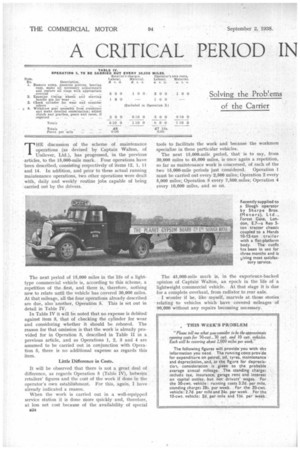A CRITICAL PERIOD IN THE LIGHT LORRY'S LIFE
Page 34

Page 35

If you've noticed an error in this article please click here to report it so we can fix it.
THE discussion a the scheme of maintenance operations (as devised by Captain Walton, of . Unilever, Ltd.), has progressed, in the previous
• articles, to the 15,000-mile mark. Four operations have • been described, consisting respectively of items 12, 1, 11 and 14. In addition, and prior to these actual running maintenance operations, two other operations were dealt with, daily and weekly routine jobs capable of being • carried out by the drivers,
The next period of 15,000 miles in the life of a lighttype commercial vehicle is, according to this scheme, a repetition of the first, and there is, therefore, nothing new to relate until the vehicle has covered 39,000 miles. At that mileage, all the four operations already described are due, also 'another, Operation 5. This is set out in detail in Table IV.
In Table IV it will be noted that no expense is debited against item 3, that of checking the cylinder for wear and considering whether it should be rebored. The reason for that omission is that the work is already provided for in Operation 3, described in Table II in a previous article, and as Operations 1, !2, 3 and 4 are assumed to be carried out in conjunction with Operation 5, there is no additional expense as regards this item.
Little Difference in Costs.
It will be observed that there is not a great deal of difference, as regards Operation 5 (Table IV), between retailers' figures and the cost of the work if done in the operator's own establishment. For this, again, I have already indicated a reason.
When the work is carried out in a well-equipped service station it is done more quickly and, therefore, at less net cost because of the availability of special 1124 tools to facilitate the work and because the workmen specialize in these particular vehicles.
The next 15,000-mile period, that is to say, from 30,000 miles to 45,000 miles, is once again a repetition, so far as maintenance work is concerned, of each of the two 15,000-mile periods just considered. Operation 1 must be carried out every 2,500 miles; Operation 2 every 5,000 miles; Operation 3 every 7,500..miles; Operation 4 every 10,000 miles, and so on.
The 45,000-mile mark is, in the experience-backed opinion of Captain Walton, an epoch in the life of a lightweight commercial vehicle. At that stage it is due for a complete overhaul, from radiator to rear axle.
I wonder if he, like myself, marvels at those stories relating to vehicles which have covered mileages of 90,000 without any repairs becoming necessary. Operation 6, described in Table V. comprises only two items, but they are most comprehensive ones. There are two striking features about the figures for cost, which will most likely evoke comment and, possibly, criticism. In the first place, there appears to be a wide discrepancy as between actual experience and the figures which were set out under the heading of "Retailer's Charges." It is most unusual for the proportions of expenditure on labour and materials to be 16 to 77. The explanation is this.
Value of the Unit-replacement Scheme.
For engine, clutch, gearbox and rear axle recourse is presumed to be had to the unit-replacement scheme which is available from most manufacturers of light vehicles.' It means -that, when the overhaul is carried _out, these units are acquired and erected in the cha csis in place of the old ones. The price of the replacement unit appears, therefore, as "material," and this pro
vision entirely ignores the fact that, in that price, there
is a considerable proportion of labour cost which does not appear as a separate item.
All that arises in the way of labour expense is the lifting-out of the old units and the fixing of the new ones, and that expense is small in comparison. Provision is made, of course, for cost of labour in dealing with the many sundry items which cannot be dealt with by the unit-replacement system.
The figures in the: second column, relating to the operator's own costs of maintenance, do not show quite the same discrepancy as that which I have just explained.. There it is assumed that the operator dismantles the engine and gearbox and rear axle himself, renovating such parts as are worth that expense and replacing those which need it. The cylinders, it is assumed, are sent out to be rebored and resleeved and new pistons are purchased. There is thus a better balance, as between labour and material cost, than in the other case. S.T.R.




















































































